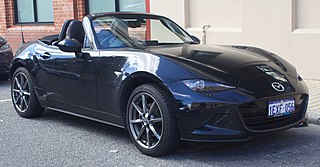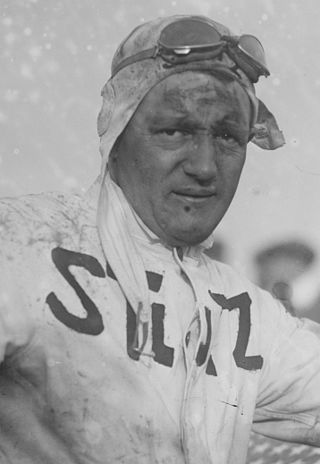
A roadster is an open two-seat car with emphasis on sporting appearance or character. Initially an American term for a two-seat car with no weather protection, its usage has spread internationally and has evolved to include two-seat convertibles.
Black Hawk and Blackhawk may refer to:

In automotive engineering a multi-valve or multivalve engine is one where each cylinder has more than two valves. A multi-valve engine has better breathing and may be able to operate at higher revolutions per minute (RPM) than a two-valve engine, delivering more power.

The Stutz Bearcat was an American sports car of the pre– and post–World War I period.
The bearcat, also known as the binturong, is a viverrine mammal from Southeast Asia.

The Stutz Blackhawk is an American luxury car manufactured from 1971 through 1987. Other than the name, it bears no resemblance to the original Blackhawk (1929–1930). Prices ranged from US$22,500 to US$75,000. All early Blackhawks were coupes, but rare sedans were produced later. Convertible versions were called D'Italia and Bearcat. By 1976, Stutz had sold 205 Blackhawks, and about six a month were handbuilt in Italy and shipped to the U.S. By April 1980, 350 Blackhawks had been sold, and by the time production ended in 1987, approximately 500 to 600 cars had been manufactured.

The Stutz Motor Car Company was an American automobile manufacturer based in Indianapolis, Indiana that produced high-end sports and luxury cars. The company was founded in 1911 as the Ideal Motor Car Company before merging with the Stutz Auto Parts Company in 1913. Due to the pressures of the Great Depression, the Stutz company went defunct in 1938. The Stutz Motor Car Company produced roughly 39,000 automobiles in their Indianapolis factory during their existence.

The Stutz IV-Porte were sedans produced by the Stutz Motor Car of America company in the 1970s and 1980s. The Stutz Diplomatica and later Royale were limousines produced by the Stutz Motor Car of America company in the 1970s and 1980s. All these cars shared characteristic design features, such as a spare tire protruding through the trunklid and freestanding headlamps as well as a very luxurious interior, with the Stutz Blackhawk coupe designed by Virgil Exner.
Royale is simply the French feminine form of Royal. Royale is used to describe luxury or high-end products.

Frank Stallworth Lockhart was an American racing driver active in the 1920s, considered by many historians to be a legend in the sport on par with Jim Clark, 1960s British World Drivers' Champion. During a "remarkable if all too short" career, Lockhart won numerous races on both dirt and board tracks, and the 1926 Indianapolis 500. In all, he scored nine AAA championship race wins and two vice-championships in two years of competition. Having set a world land speed record at the Muroc dry lake in April 1927, Lockhart was killed during another speed record attempt at Daytona Beach a year later.
The 1928 24 Hours of Le Mans was the 6th Grand Prix of Endurance that took place at the Circuit de la Sarthe on 16 and 17 June 1928.
Bearcats! is an American Western television series broadcast on the CBS television network during the fall 1971 television season. It starred Rod Taylor and Dennis Cole as troubleshooters in the period before the American entry into World War I (1917).

Gilbert J. Andersen was an American racing driver active during the formative years of auto racing.
Alexander Kennedy Miller, also known as A. K. Miller, was an eccentric recluse who operated Miller's Flying Service in 1930, in Montclair, New Jersey, US. Miller provided mail and other delivery services by means of an autogyro, as well as listing "Expert Automobile Repairing" and "Aeroplanes Rebuilt & Overhauled" on his business card. In his later years he was known for his eccentricities, and his collection of valuable antique cars.

Harry Clayton Stutz was an American automobile manufacturer, entrepreneur, self-taught engineer, and innovator in the automobile industry. Stutz was part of the burgeoning Indianapolis automotive industry of the early 20th century, where he founded the Ideal Motor Car Company, later known as the Stutz Motor Car Company, and the short-lived H. C. S. Motor Car Company.
Asphalt most often refers to:
Stutz is a surname that may refer to:

The Sudbury Five are a Canadian professional basketball team based in Sudbury, Ontario that play in the Basketball Super League (BSL). The team is owned by Sudbury Wolves Sports and play at the Sudbury Community Arena.

H. C. S. Motor Car Company was a short-lived Indianapolis, Indiana, automobile manufacturer. It may have built as many as 3,000 cars between the summer of 1920 and 1926, when its doors were closed by its creditors.

The Pak-Age-Car Corporation was a Chicago-based company building a small walk-in delivery van from 1926 until 1941. The truck was designed to replicate what a horse-drawn delivery carriage could do, and looked a little like a horse-drawn wagon without the animal. The company belonged to the Mechanical Manufacturing Company of Chicago, and from 1927 on they were distributed through the Stutz dealer network.
This page is based on this
Wikipedia article Text is available under the
CC BY-SA 4.0 license; additional terms may apply.
Images, videos and audio are available under their respective licenses.











